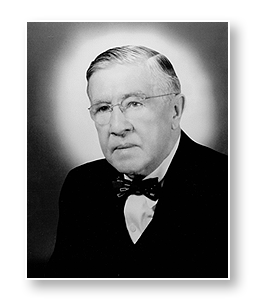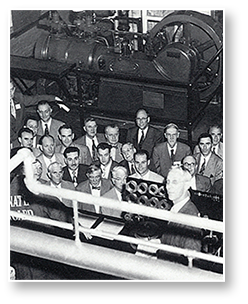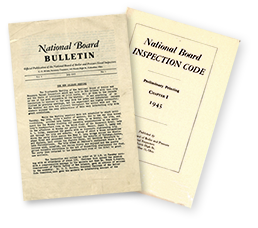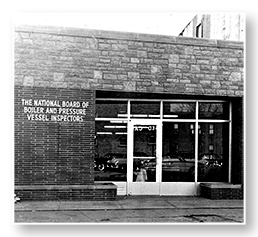

The Beginning
In June 1919, Carl O. Myers, Ohio's chief boiler inspector, stressed the need for an organization that could enforce uniform qualification for inspectors in all jurisdictions. With three other chief inspectors, he began to draw up plans to form that organization. On December 2, 1919, Myers and six other chief inspectors formed an organization called "The National Board of Boiler and Pressure Vessel Inspectors."
In 1921, he stated,"The National Board is the states consolidated into one body which may be termed the enforcement body of the ASME Boiler Code Committee, and we have three primary objects in view, which are: one code, one inspector, and one stamp."
A Decade of Firsts
On February 2-4, 1921, the National Board held its first General Meeting in Detroit, Michigan. Before the meeting, ASME Council authorized the National Board to appoint one member to its Boiler Code Committee, with C. O. Myers becoming the first delegate. The National Board's first General Meeting coincided with the ASME Boiler Code Committee's session, establishing the first joint conference of the two organizations. This year, ASME and the National Board will host the 88th General Meeting in Salt Lake City, Utah.
It was at the first General Meeting that the National Board's constitution and bylaws were amended and formally adopted. The constitution allowed manufacturers to register boilers and file data reports. Registration with the National Board indicated a desire to support uniformity in design, construction, and inspection.

National Board Laboratories
In 1935, C. O. Myers contracted with Robinson Laboratory at The Ohio State University to conduct capacity tests of safety valves, which continued for 37 years. In 1974, a new lab was built, located at the site of Columbus and Southern Ohio Electric Company's Picway Generating station, serving its purpose for roughly 17 years.
Today, the state-of-the-art National Board Testing Laboratory is located two miles from the National Board's headquarters. The lab contains three test systems using steam, nitrogen, and water, and is capable of pressure relief device attachment; a high-pressure air system for testing smaller pressure relief devices; and a computer-based data acquisition system for fluid flow computation and analysis.

The Publication Era
An objective of the National Board was and is to gather and provide information regarding the boiler and pressure vessel industry.
In 1943, C. W. Obert and C. O. Myers printed the first BULLETIN, a publication that is a staple of the National Board. Today, the BULLETIN is in its 76th year of publication, continuing to relay industry news and information to its subscribers.
In 1945, the National Board published the first chapter of the National Board Inspection Code (NBIC). In its current edition, the NBIC provides rules and guidelines for the installation, inspection, repair, and alteration of boilers, pressure vessels, and pressure relief devices. The NBIC became a national standard by the American National Standards Institute (ANSI) in 1983.

A Place to Call Home
Due to an increased volume of data report registrations, C. O. Myers recognized the need for expansion, and in April 1955, the National Board moved into its own newly erected building at 1155 N. High Street, Columbus, Ohio.
From 1955 through the early 1970s, the National Board quickly outgrew its offices. In 1974, construction began on a new, larger headquarters. A year later, the National Board staff moved into its current location at 1055 Crupper Avenue. In 1998, the Training and Conference Center opened adjacent to the headquarters. The National Board campus expanded again with the opening of the Inspection Training Center in 2008.
National Board Training
With the expansion of the industry and its technology, the National Board decided it was necessary to "upgrade" their inspectors to ensure they would have the expertise to inspect highly sophisticated equipment and systems. In 1967, the Executive Committee authorized E. O. Peterson to arrange for a training course. The training course was established using The Ohio State University Department of Welding Engineering professors as instructors.
Today, the National Board is the world leader in pressure equipment training. Each year, its training program hosts hundreds of boiler and pressure equipment professionals from the United States and dozens of other countries. Each National Board training session is taught by a faculty of experienced National Board technical staff.

Accreditation Programs
The National Board administers three accreditation programs for organizations performing repairs and alterations - the R, VR, and NR stamps. Authorized repair organizations are issued symbol stamps for application to equipment nameplates signifying the integrity of work performed.
The R stamp was introduced in 1975. It is the most recognized emblem of international quality and safety for pressure equipment post-construction repairs and alterations.
The VR Certificate of Authorization, which provides for repairs and modification to pressure relief devices, was introduced in 1976. The NR Certificate of Authorization, which is issued for repairs and replacement of nuclear components, was launched in 1979.

Establishing Endorsements
The commissioning program has gone through many changes since the first commission was issued in 1921. Modifications to commissions were refined to keep pace with additions and revisions to the ASME Boiler and Pressure Vessel Code. Changes in the code made it necessary to add endorsements focusing on specialized qualifications which required commissioned inspectors to perform certain duties in accordance with the ASME Code.
In 1983, the National Board Constitution and Bylaws authorized the recognition of ASME N-626.0, Qualifications and Duties for Authorized Inspection Agencies, Nuclear Inspectors, and Nuclear Inspector Supervisors. This established the B, S, N, C, and I endorsements.
The National Board Enters the Digital Age
The 1990s brought advancements in technology and communication to the National Board. At the 65th General Meeting in 1996, the National Board launched its website. With the introduction of the website came an entirely new way to relay and gather information. The National Board began to use the internet to reach a broader audience of both industry professionals and the public.
In 1997, the Manufacturers Directory was posted to the National Board website. The next year, Rules for Commissioned Inspectors was added.
Electronic Data Transfer (EDT) was introduced in 1999. EDT established a system where manufacturers could submit their data reports electronically to the National Board instead of mailing paper reports.

A New Millennium
The National Board embraced the turn of the century with a sense of heightened productivity. Advances in digital technology continued as the first of several planned online training courses—Controls and Safety Devices for Automatically Fired Boilers, or CSD-1—was launched in March 2004.
In January 2017, the National Board's Training Department launched its new Online Education Center. The center offers more than 60 courses, including inservice, new construction, nuclear, and general code knowledge topics. It allows students to enroll and complete online training, review a list of completed online and classroom training, print certificates from online and classroom training, and print transcripts that show a list of training and exams taken with completion dates and credentials.
100 Years and Counting...
As the National Board celebrates its 100 year anninversary, what does the next 100 years hold for pressure vessel advancement and safety?
In the tradition of their forefathers, today's National Board members and industry partners continue to rise to the opportunities before them and will continue the legacy of safety for another 100 years.